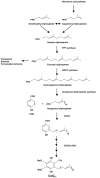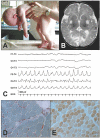Leigh syndrome with nephropathy and CoQ10 deficiency due to decaprenyl diphosphate synthase subunit 2 (PDSS2) mutations
- PMID: 17186472
- PMCID: PMC1698707
- DOI: 10.1086/510023
Leigh syndrome with nephropathy and CoQ10 deficiency due to decaprenyl diphosphate synthase subunit 2 (PDSS2) mutations
Abstract
Coenzyme Q(10) (CoQ(10)) is a vital lipophilic molecule that transfers electrons from mitochondrial respiratory chain complexes I and II to complex III. Deficiency of CoQ(10) has been associated with diverse clinical phenotypes, but, in most patients, the molecular cause is unknown. The first defect in a CoQ(10) biosynthetic gene, COQ2, was identified in a child with encephalomyopathy and nephrotic syndrome and in a younger sibling with only nephropathy. Here, we describe an infant with severe Leigh syndrome, nephrotic syndrome, and CoQ(10) deficiency in muscle and fibroblasts and compound heterozygous mutations in the PDSS2 gene, which encodes a subunit of decaprenyl diphosphate synthase, the first enzyme of the CoQ(10) biosynthetic pathway. Biochemical assays with radiolabeled substrates indicated a severe defect in decaprenyl diphosphate synthase in the patient's fibroblasts. This is the first description of pathogenic mutations in PDSS2 and confirms the molecular and clinical heterogeneity of primary CoQ(10) deficiency.
Figures


Similar articles
-
Respiratory chain dysfunction and oxidative stress correlate with severity of primary CoQ10 deficiency.FASEB J. 2008 Jun;22(6):1874-85. doi: 10.1096/fj.07-100149. Epub 2008 Jan 29. FASEB J. 2008. PMID: 18230681 Free PMC article.
-
Primary coenzyme Q deficiency in Pdss2 mutant mice causes isolated renal disease.PLoS Genet. 2008 Apr 25;4(4):e1000061. doi: 10.1371/journal.pgen.1000061. PLoS Genet. 2008. PMID: 18437205 Free PMC article.
-
Missense mutation of the COQ2 gene causes defects of bioenergetics and de novo pyrimidine synthesis.Hum Mol Genet. 2007 May 1;16(9):1091-7. doi: 10.1093/hmg/ddm058. Epub 2007 Mar 20. Hum Mol Genet. 2007. PMID: 17374725 Free PMC article.
-
Clinical, biochemical and molecular aspects of cerebellar ataxia and Coenzyme Q10 deficiency.Cerebellum. 2007;6(2):118-22. doi: 10.1080/14734220601021700. Cerebellum. 2007. PMID: 17510911 Review.
-
[Progress in mitochondrial nephropathy].Zhonghua Er Ke Za Zhi. 2014 Jul;52(7):503-5. Zhonghua Er Ke Za Zhi. 2014. PMID: 25224054 Review. Chinese. No abstract available.
Cited by
-
Update on clinical aspects and treatment of selected vitamin-responsive disorders II (riboflavin and CoQ 10).J Inherit Metab Dis. 2012 Jul;35(4):679-87. doi: 10.1007/s10545-011-9434-1. Epub 2012 Jan 10. J Inherit Metab Dis. 2012. PMID: 22231380 Review.
-
Mitochondrial respiration without ubiquinone biosynthesis.Hum Mol Genet. 2013 Dec 1;22(23):4768-83. doi: 10.1093/hmg/ddt330. Epub 2013 Jul 11. Hum Mol Genet. 2013. PMID: 23847050 Free PMC article.
-
Loss of MTX2 causes mitochondrial dysfunction, podocyte injury, nephrotic proteinuria and glomerulopathy in mice and patients.Int J Biol Sci. 2024 Jan 12;20(3):937-952. doi: 10.7150/ijbs.89916. eCollection 2024. Int J Biol Sci. 2024. PMID: 38250156 Free PMC article.
-
Prenyldiphosphate synthase, subunit 1 (PDSS1) and OH-benzoate polyprenyltransferase (COQ2) mutations in ubiquinone deficiency and oxidative phosphorylation disorders.J Clin Invest. 2007 Mar;117(3):765-72. doi: 10.1172/JCI29089. J Clin Invest. 2007. PMID: 17332895 Free PMC article.
-
Treatment of CoQ(10) deficient fibroblasts with ubiquinone, CoQ analogs, and vitamin C: time- and compound-dependent effects.PLoS One. 2010 Jul 30;5(7):e11897. doi: 10.1371/journal.pone.0011897. PLoS One. 2010. PMID: 20689595 Free PMC article.
References
Web Resource
-
- Online Mendelian Inheritance in Man (OMIM), http://www.ncbi.nlm.nih.gov/Omim/ (for coenzyme Q10 deficiency, COQ2, PDSS1, COQ3, COQ7, CABC1, APTX, and AOA1)
References
-
- Kawamukai M (2002) Biosynthesis, bioproduction and novel roles of ubiquinone. J Biosci Bioeng 94:511–517 - PubMed
-
- Sobreira C, Hirano M, Shanske S, Keller RK, Haller RG, Davidson E, Santorelli FM, Miranda AF, Bonilla E, Mojon DS, Barreira AA, King MP, DiMauro S (1997) Mitochondrial encephalomyopathy with coenzyme Q10 deficiency. Neurology 48:1238–1243 - PubMed
Publication types
MeSH terms
Substances
Grants and funding
LinkOut - more resources
Full Text Sources
Medical
Molecular Biology Databases

